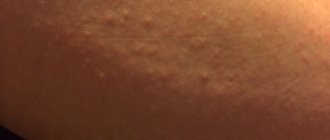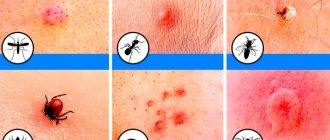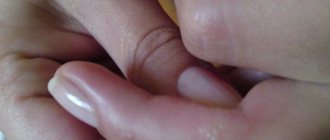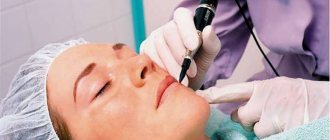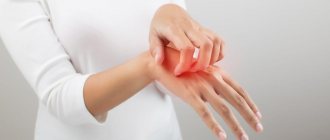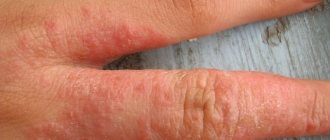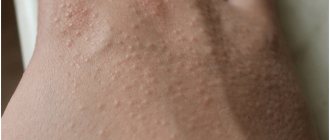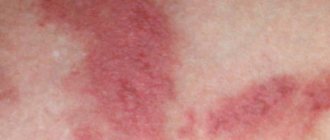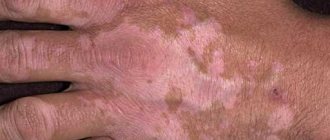Anyone can experience rashes on their hands, since these areas of the body are most susceptible to external factors. The rash is often accompanied by redness, swelling and severe itching . If pimples appear on your hands and itch, there can be a great many reasons for this, ranging from a banal allergy to an infection or disease of the internal organs. Therefore, in such a situation, it is necessary first of all to consult a doctor and not self-medicate, so as not to aggravate the course of the dermatological illness.
Causes of acne formation
Pimple (acne) is an inflammatory disease of the sebaceous glands that occurs as a result of their blockage and increased production of sebum. Pimples can appear anywhere on the body. Causes include the body producing too much fat, clogged pores, or various medical conditions. Acne can look different depending on the individual or the cause.
Acne is an extremely common skin condition. They are most often found on the face, back, and shoulders. Acne can affect people of any age, race, and gender. One of the common factors that cause acne is hormonal changes, which is why it usually affects young people.
Lack of vitamins
Acute vitamin deficiency can appear in various rashes, mainly cracks on the tips of the fingers, small rashes on the back of the hands and “jams” in the corners of the mouth. In young children, pimples on the hands itch and turn red; the itching can be very severe; the child constantly scratches his hands and can cause infection.
Pimples on the hands, the causes of which are associated with a lack of vitamins, need to be treated with special vitamin and mineral complexes, selected and prescribed only by a doctor. This is due to the fact that acne can occur due to a lack of various vitamins, and their overdose is just as dangerous to health as a deficiency.
Pimples on hands - causes
When the body produces too much sebum, which mixes with dead skin cells, it causes blocked pores. Bacteria on the skin infect these clogged pores, causing acne.
Keratosis follicularis
Keratosis pilaris is a skin condition that causes small, rough bumps on the skin. They are most often found on the shoulders and front of the thighs. Dead skin blocks pores and causes inflammation. Keratosis pilaris may be itchy but is otherwise harmless.
Hives
Hives appear as small red spots that can cause itching anywhere on the skin. Sometimes they are the result of an allergic reaction. An insect bite can also cause their development. A reaction to skin irritation, heat or stress usually causes a rash.
Staphylococcal infection
A staph infection can cause a rash, although it can also look like sores or blisters. Staphylococci most often live on skin areas such as the armpits and nose. If this bacteria gets into a cut, it can cause a staph infection. It is important to start treatment as soon as possible, since sometimes staphylococcal infections cause complications. A person should see a doctor if they suspect they have a staph infection.
Folliculitis
Folliculitis affects the hair follicles and can appear anywhere there are follicles. When hair follicles become damaged, bacteria can enter and cause infection. This usually appears as red spots on the skin. Folliculitis can look like pimples. Shaving, rubbing the skin, and wearing tight clothing can cause damage to hair follicles.
Chickenpox
Small pimples in the form of a rash can be a signal of the development of an infectious disease such as chicken pox. Children are more susceptible to this dermatological problem than adults. However, the last age category of people can also catch this infection, especially if the infection did not occur in childhood.
Chickenpox is very dangerous for an adult
Small watery papules with a red rim, which are localized in the area of the fingers, abdomen, face, neck, etc. speak eloquently about the presence of chickenpox. In this case, the rash brings severe discomfort to the person in the form of itching and burning. A person constantly scratches the affected areas, as a result of which the blisters open, watery contents flow out of them and a crust forms.
First of all, antiseptic treatment of the resulting small rash is required. Manipulations are carried out using a diamond solution, treating each pimple separately. In more severe cases, oral antiviral drugs are indicated. Also, drugs in this group are used for topical application. For this purpose, Zovirax, Panavir, Acyclovir and other topical agents are used. These medications promote faster recovery and also prevent the appearance of scars that may form after the blisters burst.
Treatment of acne on hands
Skin infections that cause acne often go away without treatment. Warm compresses can relieve the symptoms of folliculitis. Sometimes a staph infection requires treatment with antibiotics. This occurs if a person develops a rash that lasts longer than a week, gets worse, or spreads quickly.
See your doctor if the cause of your acne is unclear. An allergy test can often help pinpoint the cause of a reaction. A person can avoid this allergen to prevent a future reaction.
Acne may require treatment with medications. Drug treatments include ointments and lotions that a person applies to the skin that kill bacteria or reduce the amount of oil produced by the skin. Continued treatment may prevent acne from recurring.
Laser therapy, light therapy and chemical peels are other acne treatments. This therapy helps remove bacteria from the skin or its top layer to unclog pores.
Treating dry skin can help clear keratosis pilaris or reduce the appearance of acne. Applying moisturizer two or three times a day will prevent your skin from drying out. Gently massage into skin after shower or bath for best results.
How to treat allergies
When experiencing skin rashes, many people look at their hands with horror, begin to panic and wonder what to do. There is no need to panic. First of all, to avoid complications, you need to start washing your hands with bactericidal, preferably liquid soap.
Household chemicals often lead to similar phenomena. The skin of the hands is sensitive and cannot withstand the onslaught of chemicals, as well as frequent contact with water. It is better to wear gloves when washing and using powders.
For itching and burning, you can use skin-soothing mash, baths with the addition of chamomile, or string. Baths with peat oxidate and a water temperature of 37°C help well. You need to repeat the procedure for several days. If a scabies mite has penetrated the skin, you cannot avoid treating the skin with Spregal, Benzyl benzoate. In this case, it is necessary to disinfect all things, treat them thermally or even chemically.
Allergies should not be confused with scabies. These are completely different diseases that differ in symptoms and treatment. It is best to seek help from a doctor immediately.
Infectious diseases
Pimples on the arms from the shoulder to the hands, and especially on the hands, may be evidence of a fungal infection, lichen, or a bacterial infection, mainly caused by Staphylococcus aureus.
In these cases, pimples on the hands are red pimples with purulent or serous contents, which can increase in size and “spread” over the surrounding tissues. Pimples on the fingers are treated with drugs that correspond to the causative agent of the disease.
In this case, a visit to a dermatologist is mandatory, since the disease may have similar symptoms to eczema, various lichens, allergies and other diseases.
Prevention
It is quite possible to avoid the formation of weeping, watery pimples on the skin of your hands. Provided there are no chronic diseases and the following recommendations are followed, this problem will never arise:
- careful personal hygiene, absence of the habit of using other people's towels and other hygiene items;
- proper and high-quality hand skin care, regular use of good cosmetics, creams to nourish and moisturize the epidermis;
- timely treatment with antiseptics of even minor and imperceptible scratches and damage;
- strengthening the immune system in various ways;
- timely seeking medical help if skin problems arise.
Only if you pay close attention to your health can you avoid the development of many diseases that often affect the condition of your skin.
Allergic reactions
Most often, red pimples on the hands are an allergic reaction. The rashes are pimples of all sizes on the arms from shoulder to elbow, on the wrists. They are usually very itchy, and pimples on the arms from the shoulder to the elbow can be large and quite painful.
Sometimes allergies look like burn marks on your hands. This usually happens due to a contact reaction - applying the wrong cream, detergent, chemicals, and so on. Pimples on the arms above the elbow usually occur due to food allergies, as well as when various aerosol drugs come into contact with woolen clothing.
Diseases of internal organs
Pimples between the fingers can also appear as a result of various internal diseases. This is mainly due to digestive problems, but various hormonal imbalances also carry a high risk of rashes.
Usually the appearance of hormonal acne is associated with the menstrual cycle, but an abscess appearing on the arm is also a common occurrence. Sometimes an itchy pimple or entire spots on the hands are caused by problems with metabolism.
The appearance of acne is an alarm signal that cannot be ignored. Timely measures taken will protect you from many troubles in the future.
Scabies
Signs of scabies include an itchy hand and watery pimples. The bottom line is that between the fingers the skin is thinner than in other places and in this case the skin mite pierces the skin and lays eggs, then crawls further under the skin and lays eggs again.
There are several ways to determine that a patient has become infected with scabies:
- Use a needle to pry and remove the female mite from the pimple.
- Using microscopy. This method allows you to identify not only the tick, but also the laying of eggs.
- Layer-by-layer scraping technique.
Scabies is usually treated with sulfur ointment, but the doctor may also prescribe other treatments:
- Benzyl benzoate;
- Pyrethrins and pyrethroids;
- Spregal;
- Lindan;
- Krotamion;
- Ivermectin.
Even if the patient has completed the full course of treatment, itching and some types of scabies symptoms may remain. This is due to the fact that the body still tries to identify foreign bodies for some time. And therefore, if the itching becomes unbearable, the doctor may prescribe medications that relieve scabies.
Parasitic lesions
Small pimples on the hands can be manifestations of scabies. The tick gnaws passages under the skin between the fingers, leaving pairs of red pimples that can bleed or fester. At the same time, whitish traces are visible under the skin on the finger - the passages of the parasite. The only way to remove acne is with special anti-itch products.
WE RECOMMEND: Effect of salicylic enzyme peeling “Stopproblem” and reviews
The disease must be treated very quickly, since scabies is a very contagious disease, which also causes many unpleasant moments for the sick person. Pimples and wounds on the hands are very itchy, and scratching them can easily cause infection, which will seriously complicate an already difficult situation.
